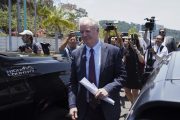
An advance contingent of about 400 migrants who separated from the larger caravan of Central Americans who intend to illegally enter the United States arrived at the border city of Tijuana, Mexico, on November 13. About 80 of them, who identify as LGBT, splintered off from the larger group in Mexico City, claiming that they received discriminatory treatment by local residents and other caravan travelers.
One of them, a Honduran migrant named Cesar Mejia, told reporters at a news conference on November 11, “Whenever we arrived at a stopping point the LGBT community was the last to be taken into account in every way. So our goal was to change that and say, ‘This time we are going to be first.’ ”
NPR cited a Univision report stating that as their number grew, these “LGBT” migrants linked up with an assortment of U.S. and Mexico-based LGBT groups that paid for them to travel by bus. That, apparently, was how they reached the border ahead of the main caravan.
“When we entered Mexican territory, those organizations began to help us. We did not contact them; they learned from our group thanks to the media and decided to help us,” NPR quoted Mejia as saying.
Dozens of the migrants climbed a border fence that crossed a Pacific coast beach, while others jumped and crawled through openings in the fence. However, they were seen running back to the Mexico side when U.S. Border Patrol agents approached.
Military personnel worked through Veterans Day weekend to “harden” the U.S. border.
The U.K.-based Guardian reported that U.S. Secretary of Defense Jim Mattis said he would travel to the border area on November 14, his first visit to the area since the administration announced that over 7,000 troops would be sent to secure the border.
U.S. Customs and Border Protection (CBP) said in a statement that it would close lanes at the San Ysidro and Otay Mesa crossings from Tijuana to allow the Department of Defense to install razor wire and position barricades and fencing.
“CBP has been [preparing] and will continue to prepare for the potential arrival of thousands of people migrating in a caravan heading towards the border of the United States,” Pete Flores, the agency’s director of field operations in San Diego, said in a statement, citing a “potential safety and security risk.”
Related articles:
“Migrant Caravan” Dwindles As Barbed Wire Goes Up
60K Aliens Nabbed at Border in Oct. — 521K in Fiscal 2018
Another U.S.-bound Caravan Crosses Into Mexico With Homemade Bombs and Guns
Migrants Not Stopping — Vow To Storm U.S. Southern Border
Migrant Invasion Force Doubles and Another From El Salvador Starts
Migrant Caravan No. 2 Heads North, Trump Threatens to Cut Aid to Honduras





